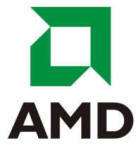AMD Imageon Powers Up Cellphone Graphics

At CTIA 2007, AMD showed off its latest series of Imageon graphics chipsets for cell phones.
The idea behind the Imageon chip is similar to the way a desktop PC works with an accelerated graphics card. Instead of relying on the main CPU to provide graphics acceleration, which usually results in sluggish animation and poor texture detail, AMD's Imageon chips offload graphics processing and handle it separately. This provides for significantly more detailed graphics and faster frame rates.
AMD had a series of "mock-up" handsets on display; these were much larger than usual phones and had a prototype look to them; see the slideshow for examples. But the chips, software, and screens demonstrating the Imageon line were real.
In a demonstration of their new gaming-oriented Imageon 238X chip, AMD showed off a handset running code from an actual Xbox game, Sudeki. In this case, it was scaled down to a QVGA (320x240-pixel) cell phone screen, but the demo ran just as smoothly as you'd expect on a proper gaming PC.
AMD also showed off another prototype phone equipped with an Imageon 2X9X chip. It was decoding a H.264 signal, displaying standard-definition-DVD quality video on an external 37-inch LCD panel.
At first glance, the image looked just like a regular DVD. It was ever so slightly blurry, but it was something that only a trained eye would notice; for example, someone who is tuned in to the video quality differences between DVD players could probably tell something was amiss. Still, it looked great and was definitely in the ballpark for standard definition DVD – all coming from a cell phone graphics chip.
Since the chip allows for multitasking, AMD spokesperson Victor Fong demonstrated what would happen when a call comes in. Instead of dropping out of video playback entirely, the phone displayed a small "picture-in-picture" window (see slideshow) that contained a picture of the person calling, and played the ringer sound at the same time, while the movie was still playing. Once the call was ignored, the PIP window disappeared – pretty slick for a cell phone.
AMD also demonstrated Imageon TV, their mobile TV-capable system that can receive and decode DVB-H broadcast television signals.
All three series of Imageon chips are now available to cell phone manufacturers; no word yet on when the first handsets will arrive.
Copyright 2007 by Ziff Davis Media, Distributed by United Press International





















